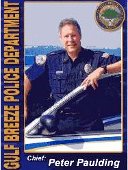7/12/2012
Florida: Early Red Light Camera Program Failed to Reduce AccidentsAnalysis of one of the first Florida red light camera programs shows it failed to reduce accidents.

One of the first Florida towns to rush into the use of red light cameras has seen an increase, not a decrease, in the number of accidents since the devices were installed. According to an analysis released Monday by a retired Florida Highway Patrol lieutenant, Gulf Breeze had no particular problem with collisions at its intersections when it decided to ignore a ruling by the attorney general and install automated ticketing machines in March 2006.
Paul Henry obtained from the state transportation department a set of accident reports for US 98 and Daniel Drive, the city's photo enforced intersection. Over fifty-three month period, the location saw just just sixteen crashes, none of which were fatal. Only one of these incidents involved red light running, and Henry found police cited the driver who was responsible with driving under the influence of alcohol.
"Automated enforcement in the author's experience will not affect an impaired or inattentive driver," Henry noted. "The crash volume at this intersection is so low a couple of crashes can greatly skew the data."
Henry performed a simple before and after analysis covering one year before camera installation and up to three years after. There were 3 crashes in the before period -- one of which was the DUI -- and 2 in the first year after, meaning there was no reduction in accidents if the DUI is excluded. In the three years of photo ticketing, accidents increased slightly to an average of 3.3 per year thanks in large part to a spike of 7 accidents in 2008. The camera was deactivated for a year in 2009, and in that camera-free period, accidents dropped to 3.
"As state and other statistics show, red light running is not the epidemic that the for-profit automated device companies and some local officials make it out to be," Henry wrote.
Gulf Breeze's police chief at the time, Peter Paulding, played an instrumental role in promoting the cameras, which included making public claims about how photo ticketing had reduced accidents at the intersection. As part of the arrangement Paulding set up with the red light camera company Sensys, Gulf Breeze employees performed the ticket processing on behalf of the Swedish firm. In an April 5, 2011 memo to the city manager, Paulding recommended the processing operation be converted into a full-fledged private enterprise.
"In the future, there is significant revenue to be generated by this venture," Paulding wrote. "We will not be able to utilize our existing CJIS connection for the profit-driven back office portion of our project due to statutory and security restrictions.... We anticipate a revenue stream of $5.00 per violation processed."
Using public resources to develop this plan, Paulding suggested each Gulf Breeze employee hired would process up to 800 tickets per day, or at a pace of spending far less than 30 seconds per citation to determine guilt. Performing the review process for other cities could generate $3 million in net profit, Paulding estimated.
On August 15, 2011, Paulding formed the company Roadwatch Management Inc to run the back office, collecting $2000 per month from the city on top of whatever compensation he receives from his contract with Sensys. When Henry put together what the chief had done, he was appalled.
"I do not believe I am interpreting this incorrectly to sum this up as him using his official position to get the city to use a private enterprise to administer the automated for-profit device, and then while still in the employ of the city forming said private enterprise and then reaping a financial benefit upon retirement," Henry wrote.
A copy of the analysis is available in a 175k PDF file at the source link below. View Henry's red light camera information page.


